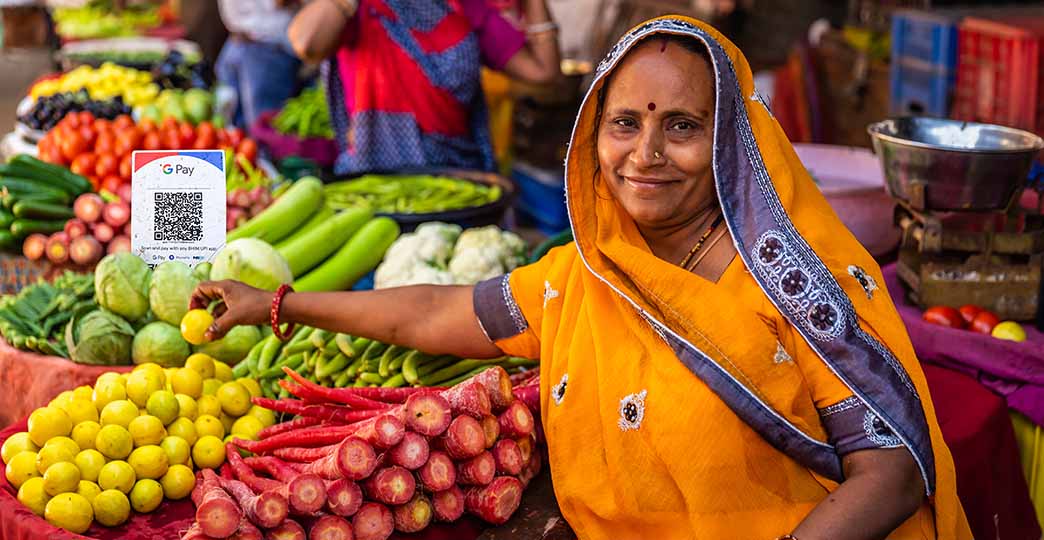Enabling India’s Digital Disruption
30 April 2024
Read Time 8 MIN
India Stack is empowering individuals, businesses, and entire communities to thrive in the digital age by leveraging mobile technology, 5G connectivity, and a robust digital infrastructure.
India’s soft infrastructure, commonly referred to as “India Stack,” is the cornerstone of India’s digital transformation. India Stack's facilitation of banking services and digital payments has promoted digital disruption in traditional businesses. It has simplified KYC (Know Your Customer) processes for financial institutions and has made digital payments ubiquitous in India. By democratizing access to financial services and formal credit across income levels, the country has created a digital ecosystem powering its economy. The systems put in place by India Stack are serving as the foundation for digital disruption across multiple industries and creating attractive investment opportunities.
Understanding India’s Soft Infrastructure – “India Stack”
At its core, India Stack consists of:
Identity layer: India’s social security number Aadhaar, a simple digital ID has (a) simplified KYC processes and lowered onboarding costs for financial institutions, (b) allowed direct benefit transfers from the government, and (c) enabled digital payment services to new bank account holders.
Payments layer: Unified Payments Interface (UPI) is India’s instant payment system that offers transaction-free seamless money transfers using the digital ID layer provided by Aadhaar.
Data layer: A digital database called “DigiLocker” (online data repository of e-documents) stores important data from Aadhaar, driver licenses, health records, and more.
Together, these systems enable online, paperless, cashless, and privacy-respecting digital access to a variety of public and private services. These elements collectively form a robust foundation for various sectors to build innovative solutions.
Foundations of India Stack
Source: VanEck.
Mobile Phone Access and 5G: Catalysts of Change
Central to India Stack's success is the widespread access to mobile phones, particularly smartphones, and the ongoing deployment of 5G technology led by Reliance Industries Ltd.’s Jio (7.9% of DGIN net assets)* and Bharti Airtel (6.7% of DGIN net assets)*. With over 158 million 5G smartphones in circulation and a projected 40% expansion by 20261, India’s mobile market is poised for exponential growth. This unprecedented connectivity is bridging the digital divide, introducing individuals to a world of digital applications and services. As smartphone penetration deepens, mobile-based solutions enabled by India Stack are becoming increasingly ubiquitous, driving financial inclusion and economic participation.
Enhancing Financial Inclusion
India Stack has been instrumental in expanding financial inclusion by making banking services more accessible. The Aadhaar-based e-KYC process has streamlined account opening, eliminating the need for cumbersome paperwork and lowering e-KYC costs for financial institutions by almost 50%2. According to industry estimates, banks’ costs of onboarding customers in India decreased from $23 to $0.10 with the use of India Stack.2 Reduced costs have made lower income clients more attractive to service and have brought millions of unbanked individuals into the formal financial system. This key initiative was led by the Indian government’s Jan Dhan Yojana, a financial inclusion program aimed at providing universal banking access to all Indian citizens.
Banking access paired with UPI has revolutionized digital payments, making transactions quick, secure, and available to all, regardless of location or socioeconomic status. Some of the 3rd party digital payments apps benefitting from increased adoption of UPI include One Communications Ltd. (1.1% of DGIN net assets)*, Walmart’s PhonePe and Google Pay. See king to capitalize on the UPI boom, Reliance Industries (7.9% of DGIN net assets)* recently introduced the Jio Pay app for merchants utilizing UPI and is selling them UPI Hub services, a centralized payment system offering small merchants the ability to accept payments and generate customer insights by collecting transaction data. Reliance also lets its cell phone customers pay using UPI via the MyJio app. Its JioBharat (inexpensive smartphone) also comes equipped to support UPI payments, creating a positive feedback loop between its e-commerce and business solutions offerings.

Source: Getty Images.
Driving Economic Growth through Credit Expansion
As financial inclusion grows, so does the potential for economic empowerment. India Stack's support of banking services and digital payments has created more avenues for income generation, especially benefiting individuals who were previously excluded from the formal economy. Through formal financial services, individuals and businesses can now access credit more easily, fueling investment, entrepreneurship, and economic growth. This symbiotic relationship between income growth and credit expansion is driving a virtuous cycle of economic development across the nation.
Since the launch of India’s financial inclusion program, 510 million new bank accounts have been3 opened. Currently, these accounts carry an average balance of about $100, totaling about $50 billion in customer accounts across India.3 The widespread adoption of digital payments and ease of onboarding customers via India Stack’s e-KYC is revolutionizing India’s fintech industry. Digital app facing non-banking financial corporations (NBFCs) are burgeoning in India, as more companies see the opportunity to extend credit to small/micro vendors and consumers. Reserve Bank of India approved at least 10 such NBFCs just over the last 3 months.4These companies offer digital payments, provide credit, and offer other financial services directly to app users. This trend is benefitting e-commerce players as well as consumer financial services companies in India, creating a strong growth trajectory for companies providing digital solutions to Indian consumers. Jio Financial Services (4.4% of DGIN net assets)* is at the forefront of digital finance in India. Some other new digital NBFCs disrupting older brick and mortar lenders among others.
India Stack’s Network Effect: Scaling up Exponential Growth
Source: VanEck as of 3/31/2024.
Enabling E-commerce, Fintech, and the Digital Economy
Companies across various industries are leveraging India Stack's digital infrastructure to innovate. The availability of digital payments through UPI has made it easier for individuals to shop online and for businesses to accept payments digitally.
India is home to about 60 million micro firms with less than 10 employees that contribute 30% to India’s GDP.5 These micro enterprises have historically lacked access to formal credit. FinTech apps are now able to leverage formalized data such as transaction value, e-bills, e-invoices etc. to underwrite loans to these micro vendors. As a result, India’s small micro enterprises are expanding offerings and using digital means to reach consumers that can also afford more via expanded credit. This is creating a positive feedback loop to lift the country’s economy.
With over 800 million users, India is the 2nd largest internet market in the world6 and e-commerce is expected to grow at 19.6% CAGR by 2030.7Companies at the center of this digitization of marketplaces in India are benefitting. Zomato (6.2% of DGIN net assets)*, a food delivery app, has seen incredible growth in its monthly transacting customers and restaurant partners. The company is seeing more growth in its Hyperpure revenue segment, which focuses on local grocery deliveries from kiryana stores (India’s bodegas) to end users. Similarly, Delhivery (1.7% of DGIN net assets)*, a leading logistics provider in India, is seeing tremendous growth from connecting the micro vendors to customers and also through B2B deliveries via their proprietary logistics model that allows for fast delivery at competitive prices. There are also other apps allowing more people to participate in the formal economy, for example, ones that let customers order home-cooked meals from stay-at-home moms.
* Data as of 3/31/2024 Source: FactSet.
** 4.9% weight in VanEck India Growth Leaders ETF (GLIN) as of 3/31/2024.
Unlocking Value
Bringing 1.4 billion people online into a digital economy is expected to unlock tremendous value. India Stack has emerged as a transformative force, driving financial inclusion, economic growth, and digital innovation in India. In the interim budget, India’s Finance Minister called India Stack a factor of production in the 21 st century facilitating savings of 32.4 billion dollars for the government or 0.9% of GDP in 2023.8 By leveraging mobile technology, 5G connectivity, and a robust digital infrastructure, India Stack is empowering individuals, businesses, and entire communities to thrive in the digital age. As India's digital economy continues to evolve, companies at the forefront of this transformation are poised for unprecedented growth. The interconnectivity of the networks created by digital integration of the economy could have knock-on effects lifting the broader Indian economy with it.
How to Invest in India with VanEck
The VanEck Digital India ETF (DGIN) offers access to the structural digital growth story of India and could be an appealing investment opportunity for investors looking to seek technology or growth exposure in emerging markets.
The VanEck India Growth Leaders ETF (GLIN) offers exposure to fundamentally sound Indian companies exhibiting attractive growth at a reasonable price across the broad Indian economy.
1 CLSA Global Research
2 DPI’s transformative impact on India extends beyond inclusive finance
3 Arvind Gupta at the FinTech Summit 2024, India
4 Economictimes.com
5 India E-Conomy Report, Bain & Co. 2023
6 E-commerce in India: Market Size, Opportunities, Growth
7 India E-commerce Market Size, Share & Growth Report 2030
8 DPI: Budget 2024 | India’s DPI new factor of production, says FM

